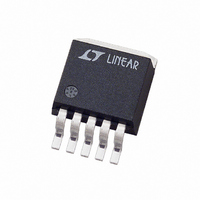LT1764AEQ-3.3#PBF Linear Technology, LT1764AEQ-3.3#PBF Datasheet - Page 15

LT1764AEQ-3.3#PBF
Manufacturer Part Number
LT1764AEQ-3.3#PBF
Description
IC LDO LOW NOISE 3A 3.3V DDPAK-5
Manufacturer
Linear Technology
Datasheet
1.LT1764AEQPBF.pdf
(20 pages)
Specifications of LT1764AEQ-3.3#PBF
Regulator Topology
Positive Fixed
Voltage - Output
3.3V
Voltage - Input
Up to 20V
Voltage - Dropout (typical)
0.34V @ 3A
Number Of Regulators
1
Current - Output
3A
Current - Limit (min)
3.1A
Operating Temperature
-40°C ~ 125°C
Mounting Type
Surface Mount
Package / Case
TO-263-5, D²Pak (5 leads + Tab), TO-263BA
Primary Input Voltage
20V
Output Voltage Fixed
3.3V
Dropout Voltage Vdo
340mV
No. Of Pins
5
Output Current
3A
Operating Temperature Range
-40°C To +125°C
Msl
MSL 1 - Unlimited
Rohs Compliant
Yes
Lead Free Status / RoHS Status
Lead free / RoHS Compliant
Available stocks
Company
Part Number
Manufacturer
Quantity
Price
APPLICATIONS
is no DC current in the output capacitor. Worst case ripple
current will occur if the output load is a high frequency
(>100kHz) square wave with a high peak value and fast
edges (< 1µs). Measured RMS value for this case is 0.5
times the peak-to-peak current change. Slower edges or
lower frequency will significantly reduce the RMS ripple
current in the capacitor.
This resistor should be made using one of the inner
layers of the PC board which are well defined. The resis-
tivity is determined primarily by the sheet resistance of the
copper laminate with no additional plating steps. Table 2
gives some sizes for 0.75A RMS current for various
copper thicknesses. More detailed information regarding
resistors made from PC traces can be found in Application
Note 69, Appendix A.
Overload Recovery
Like many IC power regulators, the LT1764A-X has safe
operating area protection. The safe area protection de-
creases the current limit as input-to-output voltage in-
creases and keeps the power transistor inside a safe
operating region for all values of input-to-output voltage.
The protection is designed to provide some output current
at all values of input-to-output voltage up to the device
breakdown.
When power is first turned on, as the input voltage rises,
the output follows the input, allowing the regulator to start
up into very heavy loads. During the start-up, as the input
voltage is rising, the input-to-output voltage differential is
small, allowing the regulator to supply large output cur-
rents. With a high input voltage, a problem can occur
wherein removal of an output short will not allow the
output voltage to recover. Other regulators, such as the
LT1085, also exhibit this phenomenon, so it is not unique
to the LT1764A series.
The problem occurs with a heavy output load when the
input voltage is high and the output voltage is low. Com-
mon situations are immediately after the removal of a
short circuit or when the SHDN pin is pulled high after the
input voltage has already been turned on. The load line
for such a load may intersect the output current curve at
two points. If this happens, there are two stable output
operating points for the regulator. With this double
U
INFORMATION
U
W
U
intersection, the input power supply may need to be
cycled down to zero and brought up again to make the
output recover.
Output Voltage Noise
The LT1764A regulators have been designed to provide
low output voltage noise over the 10Hz to 100kHz band-
width while operating at full load. Output voltage noise is
typically 50nV√Hz over this frequency bandwidth for the
LT1764A (adjustable version). For higher output voltages
(generated by using a resistor divider), the output voltage
noise will be gained up accordingly. This results in RMS
noise over the 10Hz to 100kHz bandwidth of 15µV
the LT1764A increasing to 37µV
Higher values of output voltage noise may be measured
when care is not exercised with regards to circuit layout
and testing. Crosstalk from nearby traces can induce
unwanted noise onto the output of the LT1764A-X. Power
supply ripple rejection must also be considered; the
LT1764A regulators do not have unlimited power supply
rejection and will pass a small portion of the input noise
through to the output.
Thermal Considerations
The power handling capability of the device is limited
by the maximum rated junction temperature (125°C).
The power dissipated by the device is made up of two
components:
1. Output current multiplied by the input/output voltage
2. GND pin current multiplied by the input voltage:
The GND pin current can be found using the GND Pin
Current curves in the Typical Performance Characteris-
tics. Power dissipation will be equal to the sum of the two
components listed above.
The LT1764A series regulators have internal thermal lim-
iting designed to protect the device during overload con-
ditions. For continuous normal conditions, the maximum
junction temperature rating of 125°C must not be
exceeded. It is important to give careful consideration to
differential: (I
(I
GND
)(V
IN
).
OUT
)(V
IN
– V
LT1764A Series
OUT
RMS
), and
for the LT1764A-3.3.
15
RMS
1764afb
for












